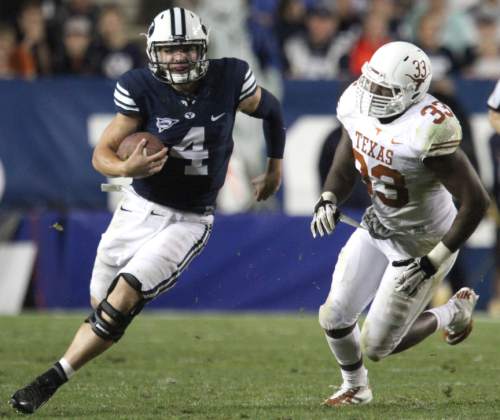This is an archived article that was published on sltrib.com in 2016, and information in the article may be outdated. It is provided only for personal research purposes and may not be reprinted.
As the Big 12 argues about its future — whether to expand, and whether to include BYU — television is right in the middle of the conversation.
Should the league form its own network? And why is that such a tough sell for Texas?
Because a league network doesn't necessarily mean more money. As we've learned from the Pac-12 experience.
Look at fiscal 2015 math: Pac-12 — $25.1 million TV revenue to each school; Big 12 — $23.3 million.
The Pac-12 number includes Tier 3 rights; $1.4 million each from the Pac-12 Network. The Big 12's numbers do not include Tier 3 rights, which vary by school.
And Texas got about $12 million from ESPN for the Longhorn network for a total of $35.3 million from TV — $2.6 million more than SEC schools; $2.9 million more than Big Ten schools; and a whopping $10.2 million more than Pac-12 schools.
You should ask — why would Texas ever jump to the Pac-12, as is often rumored?
Yes, the Longhorn Network is reportedly losing money hand over fist. But that doesn't affect the payments, which are increasing (by contract) and run another 15 years.
But SEC Network revenue is rising. And the Big Ten is negotiating a new TV deal that, according to some estimates, will bring member schools $60 million per year.
But the SEC Network (in about 70 million homes) and the Big Ten Network (about 62 million) are also much more successful than the Pac-12 Network (about 12 million).
The Pac-12 Network is one reason Utah's athletic revenue is less than all eight Big 12 schools that release such data. (Private schools Baylor and TCU do not.) That's one of the reasons Pac-12 member schools are so concerned about the conference TV channels.
And the Pac-12 Network's struggles are not just because the league owns the network and is going it alone, whereas ESPN (which owns SECN) and Fox (which owns 51 percent of BTN) muscled cable and satellite systems into carrying the channels. There are simply fewer viewers in the Pac-12's footprint — less than 20 percent of U.S. population is in the Pacific and Mountain Time Zones.
Yes, there are Utah fans in New York and Alabama fans in California, but that's not the way TV distribution works.
Speculation about BYU and Big 12 expansion often includes talk about the size of the Cougars' TV market, which has created a false impression. No, the Salt Lake market isn't huge — the 34th-largest, with .781 percent of the U.S. population (according to Nielsen). But it's bigger than seven of the 10 TV markets in the Big 12, and virtually tied with Kansas City (No. 33; .793 percent) for third.
With the exception of Dallas (No. 5; 2.335 percent) and Pittsburgh — which is West Virginia's market (No. 23, 1.019 percent) — the Big 12 is a collection of small to tiny markets — No. 39 Austin; No. 43 Oklahoma City; No. 60 Tulsa,; No. 72 Des Moines/Ames; No. 87 Waco; No. 135 Topeka,; No. 144 Lubbock.
BYU would clearly be better off in the Big 12. But — Texas aside — it wouldn't be entering as a midget in lineup of media giants.
Combined, the home TV markets of the 10 schools in the Big 12 represent just 6.97 percent of the homes in America (according to Nielsen). And that makes launching a conference network tough.
It's also tough to launch a new conference network when there are already three out there competing for space on cable and satellite systems — along with a plethora of other sports channels.
Scott D. Pierce covers TV for The Salt Lake Tribune. Email him at spierce@sltrib.com; follow him on Twitter @ScottDPierce.



